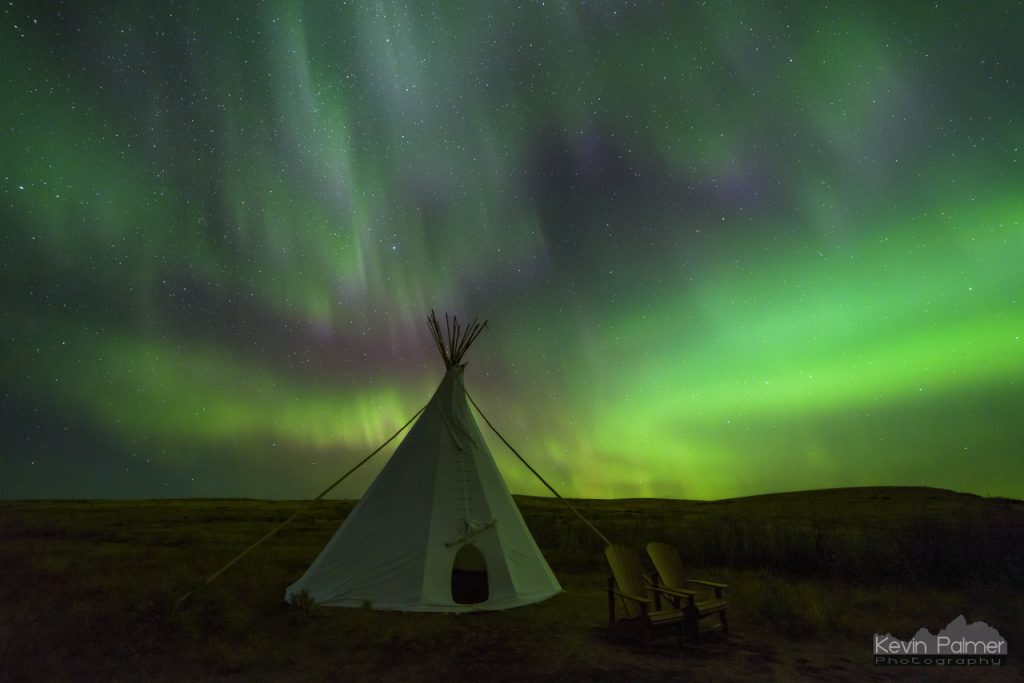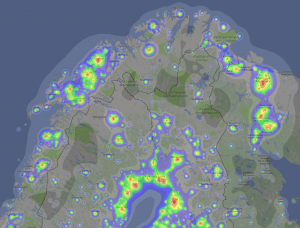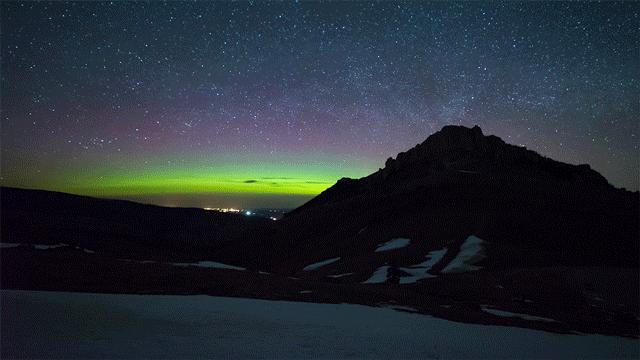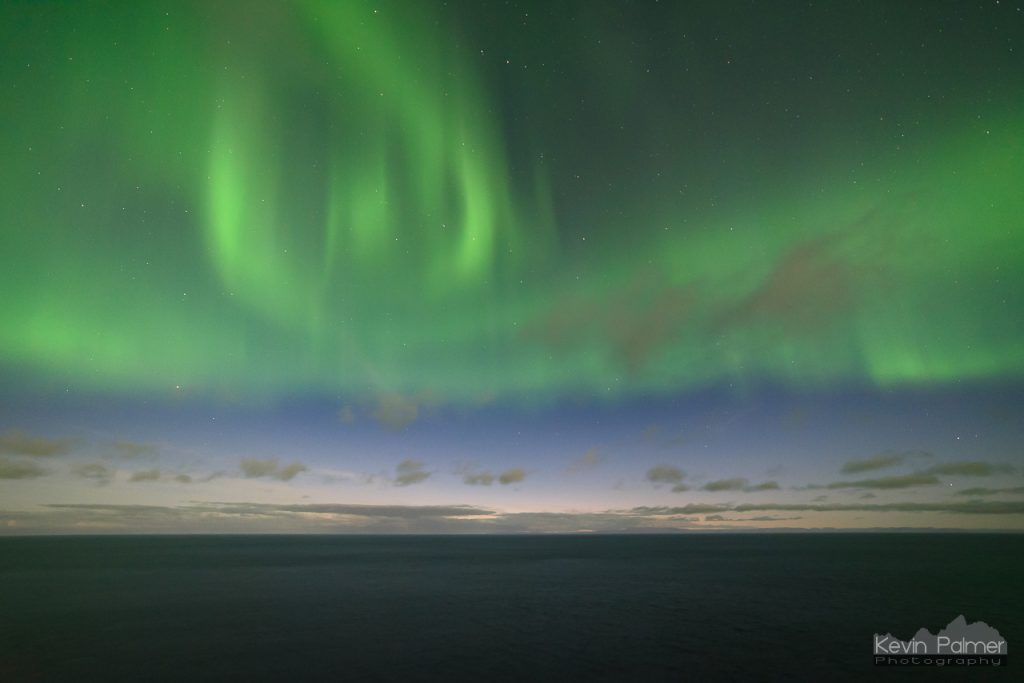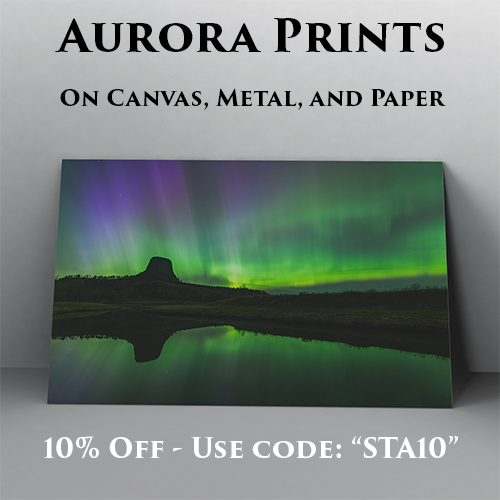I recommend reading the What Causes the Aurora post first.
Seeing the aurora is simply a matter of being in the right place at the right time. But how do you know where and when to go? What sort of conditions should you be looking for?
Live Data
The Kp-index is one of the easiest measurements of the aurora to use because it boils all the geomagnetic data down to a simple number from 0-9. On the KP Index Explained page, you can find the minimum Kp number that needs to be reached before you’ll see the aurora at a given location. Once you know this number, you can start watching the live data and looking for an increase in geomagnetic activity. At the bottom of that page you can see any watches or warnings that are in effect. The “Text Forecast” tab shows a 3-day and 27-day forecast of geomagnetic activity. You can also sign up for email alerts from NOAA, so you’re not caught off guard. Once you’re familiar with the Kp-index, you can start watching the other data. The ovation chart at the top of the page is easy enough to use. The solar wind data can be more complicated, since there are 4 or 5 different measurements. But these all go into determining the strength of the aurora. Some ideal parameters would be a Bz of -10 or lower, a proton density of 10, and a wind speed of 500+ km/s. But it’s more important to watch for trends, than to look for exact numbers since their effects can vary by location. I explain more about what each chart means on the live data page, just click on the ??? tabs next to each section.
Unpredictability
I mentioned this in the What Causes the Aurora post. There are 2 causes of geomagnetic storms – coronal mass ejection’s (CME’s) which often accompany solar flares, and coronal holes. During solar maximum both events are common. The most severe geomagnetic storms are caused by CME’s. But they are very unpredictable. Solar scientists can watch a sunspot and tell you the likelihood of a CME erupting, but it’s still hard for them to know for sure if that CME will impact earth. During solar minimum coronal holes are the most common, and they are generally more predictable. NOAA bases their 27-day forecast off of coronal hole activity tied to the approximate 27-day rotation of the sun. Coronal holes can change over time and close up or weaken. But the long term forecast is still better than nothing.
Realtime Reports
Live reports from others who are out there hunting for the aurora can be very useful. Social media is great for this. Below are a few accounts/pages to follow. The Facebook groups are some of the best resources, with many active members and a wealth of information.
- Twitter: Aurora Alerts, SpaceWeatherLive, Northern Lights Now, Aurorasaurus, Space Weather Woman
- Facebook: Great Lakes Aurora Hunters, Alberta Aurora Chasers, Aurora Hunters Iceland, Aurora Australis Tasmania
- Also check the webcams page for live views
The visibility of the aurora is affected by much more than just geomagnetic activity. Other factors that can affect your view include cloud cover, light pollution, viewing location, daylight, and moonlight.
Cloud Cover
It doesn’t matter if the Kp index is 9, if it’s completely overcast you’ll never see anything. If the aurora is bright enough then it can still shine through thin clouds, especially if light pollution and moonlight are not in play. If the aurora is low on the northern horizon, it doesn’t necessarily have to be clear overhead, it just needs to be clear to the north. Below are some resources to help you get away from the clouds.
- For average cloud cover data: Weather Spark
- For 7-day cloud cover forecasts: Clear Outside
- For current cloud cover, use an infrared satellite map. For example: RealEarth
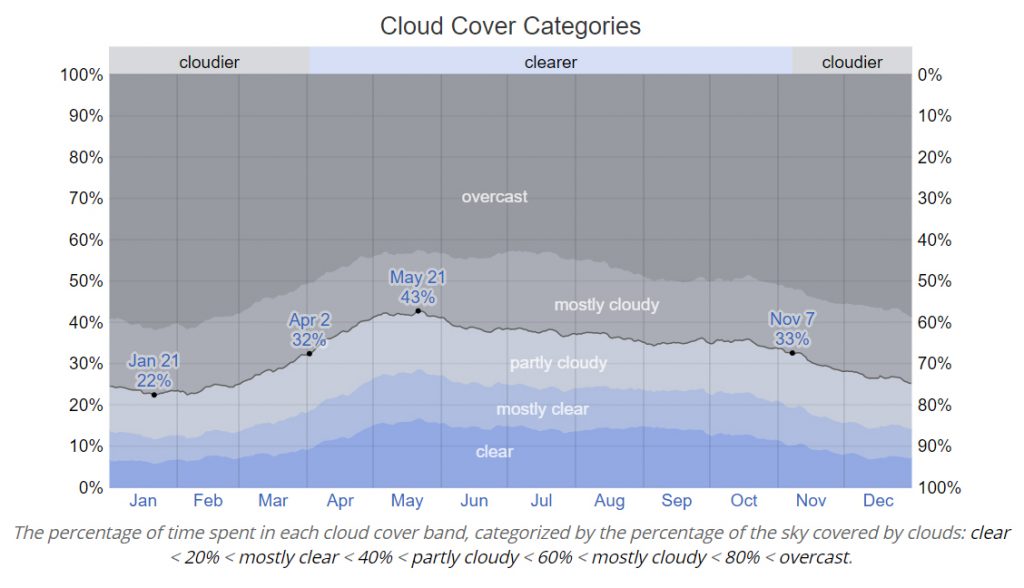
Light Pollution
Light pollution can render most of the stars and the aurora invisible. This is especially true for mid-latitude locations, where the aurora is usually confined to the northern horizon. If you can’t get to a completely dark sky, it’s important to at least find a site where there are no major cities or sources of light pollution to the north. If you are south of a major city in a mid-latitude location, nearly all aurora displays will be lost in the skyglow. In high latitudes, light pollution is less of an issue. The aurora is much brighter and will often appear overhead, which is the darkest part of the sky. But it’s still best to put yourself under a dark sky if possible. There is nothing like viewing the northern lights against a backdrop of thousands of stars.
- Worldwide light pollution map: DarkSiteFinder
Viewing Location
Besides light pollution, you also want to consider how much of the sky you can see from your viewing location. A thick forest, or a deep valley isn’t ideal. From mid-latitude locations, it’s important to have a clear view of the northern horizon. Check a topographical map or Google Earth to make sure no hills or mountains are blocking your view. Sometimes it’s better to scout out a location during the day first, before returning at night. Some of the better locations include the southern shore of a large lake (such as Lake Superior), or the top of a hill or mountain. At higher latitudes, it’s less important to have a view of the horizon. The lights may start in the north, but then spread out all across the sky. Being in a scenic location with trees or mountains may enhance your view and lead to better pictures, even if they block a portion of the sky.
Daylight and Moonlight
It goes without saying, but the aurora cannot be seen during the day. This is a big problem in the summer, when high latitude locations experience the midnight sun. Between May and August daylight may drown out the aurora completely, depending on the latitude. This is when mid-latitude locations have an advantage, because they still experience darkness during the summer. If the aurora is very bright, it may first become visible at the end of Nautical Twilight, when the sun is 12° below the horizon. But darker than this is even better. Once Astronomical Twilight ends, the sun’s light will no longer have any effect on the sky. The more hours of darkness you have, the better your odds of seeing the aurora.
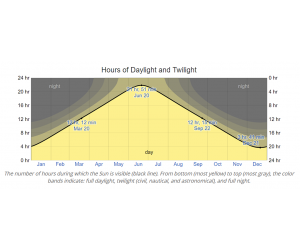
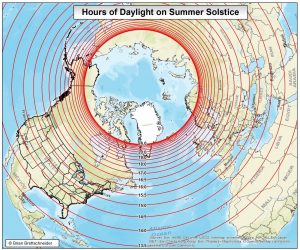
During a full moon, the aurora will show less color, and some of the dimmer portions will be harder to see. If the aurora is weak or low on the horizon, then bright moonlight may render it completely invisible. A dimmer moon will have a lesser effect. The best time for observing the aurora will be during a new moon or when the moon is below the horizon. But if photography is your main goal, then moonlight can help to illuminate the landscape so it’s not pitch black in your photos.
- For year round daylight and darkness charts: Weather Spark
- Moon phase calendar: MoonGiant
- For finding exact sunrise, sunset, moonrise, moonset, and twilight times: The Photographer’s Ephemeris
Patience and Persistence
You’ve probably picked up by now that a lot of things have to go right in order to see the northern lights. It can be frustrating when you know the aurora is going strong all day long but then it suddenly weakens just as soon as night falls in your area. Or when you know the northern lights are shining above your head, but it’s being blocked by thick clouds that you can’t escape. Many nights you’ll go home with nothing. Aurora hunting requires a lot of patience and persistence, especially from mid-latitude locations where it’s a much rarer event. Even when you do spot that elusive colorful glow you usually have to wait for the best part. The aurora is very fickle and can brighten suddenly with little warning (known as a substorm) or just as easily fade away completely. But when you finally get that incredible view of a strong aurora display, it’s all worth it. It’s simply one of the most beautiful, mesmerizing, and awe-inspiring sights in nature. The shapes, colors, and movements seem to defy physics when you’re standing right underneath it. Check out this time-lapse movie for a small taste.
If you are wondering what time of year is best for seeing the northern lights, check out the post “Aurora Stats and Averages“.
